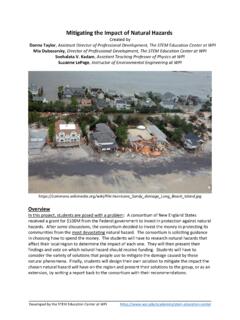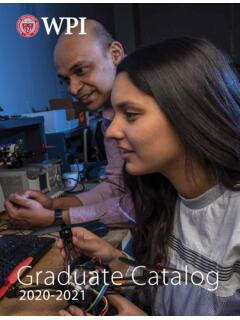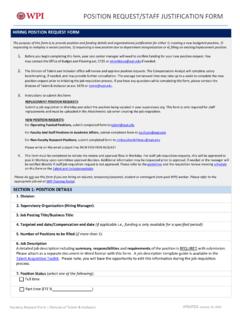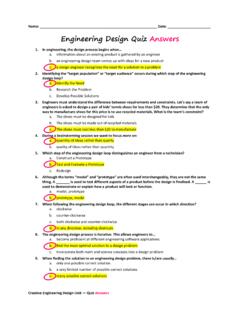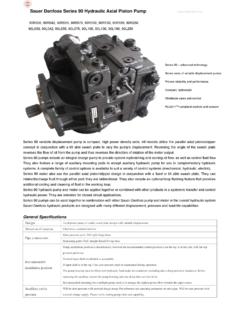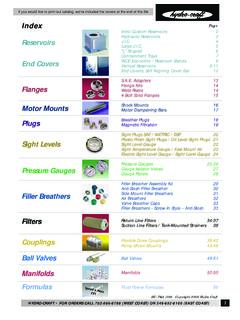Transcription of Water Filtration - Worcester Polytechnic Institute
1 Water Filtration Background 1 Water Filtration It's a modern-day engineering challenge to remove human-made contaminants from drinking Water . After a quick review of the treatment processes that municipal Water goes through before it comes from the tap you will learn about the still-present measurable contamination of drinking Water due to anthropogenic (human-made) chemicals. Substances such as prescription medication, pesticides and hormones are detected in the drinking Water supplies of American and European metropolitan cities. The engineering design process can be used to design solutions for a real-world problem (contaminated Water ) that could affect health.
2 Engineering Connection The Water that comes from our faucets has passed through a complex system designed by many different types of engineers. Civil, chemical, electrical, environmental, geotechnical, hydraulic , structural and architectural engineers all play roles in the design, development and implementation of municipalities' drinking Water supplies and delivery systems. hydraulic engineers design systems that safely filter the Water at a rate needed to supply a specific region and population. Chemical engineers precisely determine the amounts and types of chemicals added to source Water for coagulation and decontamination to make the Water safe to drink and not taste bad.
3 Even so, modern pharmaceutical and agricultural practices persist in contaminating our Water supplies. Water Filtration Background 2 Treating the Public Water Supply: What Is In Your Water , and How Is It Made Safe to Drink? Human Use of Freshwater Humans' Need for Clean Freshwater Water is perhaps the most important nutrient in our diets. In fact, a human adult needs to drink approximately 2 liters (8 glasses) of Water every day to replenish the Water that is lost from the body through the skin, respiratory tract, and urine. But some Water sources cannot safely be used to meet our requirement for drinking Water . In fact, of the Earth's Water supply is not usable by humans.
4 This unusable Water includes saltwater, ice, and Water vapor in the atmosphere. Only freshwater, which is contained in rivers, lakes, and underground sources, can be used for human consumption. Furthermore, many freshwater sources are not suitable for humans to drink. Many serious diseases, such as cholera, are caused by drinking Water that contains parasitic microorganisms. Water containing large amounts of industrial waste or agricultural chemicals ( , pesticides) can also be toxic and unfit for drinking. Hence, humans have a great need for a reliable source of clean freshwater for drinking. Water Filtration Background 3 In addition to the Water needed for drinking, humans use much larger amounts of clean freshwater in other applications.
5 These other uses of freshwater include household use ( , cooking and cleaning), industry, agriculture ( , irrigation), and recreation. Hence, the quality of the freshwater supply is important for virtually every aspect of our lives. Sources of Freshwater Where does the Water that we use come from? As stated above, saltwater is not suitable for human use. (The high salt concentration makes it unsuitable for most human applications, and removal of the salt is costly.) Water found in the forms of ice and vapor are not readily accessible for human use. This leaves only about of the Water on the Earth as liquid vast majority (approximately ) of the Earth's freshwater is contained in underground supplies known as groundwater.
6 The remaining freshwater sources, including rivers and lakes, are collectively known as surface Water . The amount of Water that we use from groundwater and surface Water varies from region to region. Generally, groundwater is cleaner and requires less treatment, but surface Water is easier to obtain. Water is Not Really Pure H2O Why is it necessary to treat freshwater before we drink it or use it for other applications? The answer is that our Water supplies are not pure, , these supplies contain other species that may make the Water unsuitable for human use. H2O is certainly the largest and most important component of any Water source, but this molecule is hardly the only chemical present in the Water supply.
7 It may be surprising to learn that Water treatment does not eliminate all of the impurities from Water . In fact, the treatment process itself contributes additional impurities to the Water . However, the impurities added during the treatment process generally help to make Water more suitable for human use. suspended particles typically have diameters in the range of 1-100 nm); however, the distinction between a suspension and a solution on the basis of particle size is not well-defined. Experimentally, the differenece between the two types of mixtures is seen using the Tyndall effect, in which light is scattered by the suspended particles in a suspension ( , the solution appears cloudy), but is not scattered in a homogenous solution.
8 Examples of suspended particles in Water samples may include: bacteria floating debris ( , twigs, bits of leaves, and trash) sand and dirt Water Filtration Background 4 The types and amounts of these species in a given Water sample depend on the source of the sample, and what sort of treatment the Water has undergone. Some of these dissolved species, such as O2 gas, are unavoidable and do not detract from our ability to use the Water . Other species, such as F-, are desirable and are often added during the Water -treatment process. Many of the species dissolved in Water , however, are harmful for humans to drink, or otherwise render the Water unsuitable for human use ( , Ca2+ is responsible for "hard Water ", which can leave insoluble scum on appliances and industrial boilers).
9 These products must be removed via Water -treatment facilities. Treatment of the Public Water Supply What, then, must be removed from public Water supplies, and what other chemicals are added to the Water ? How do public Water facilities treat our Water to make it safe for us to drink and appropriate for other human uses? There are six major steps in the treatment of our Water : screening, sedimentation, precipitation, Filtration , adsorption, and disinfection. Some of these steps, such as precipitation, involve chemical reactions among the aqueous species dissolved in the Water ; others, such as screening, involve only separation of particles on the basis of physical characteristics like size.
10 Many of these steps depend on one another. For instance, precipitation generates solids in the Water from particles that had been dissolved; these solids must then be removed through sedimentation or Filtration . We shall discuss each of the six steps in Water treatment below, and then present a schematic showing how the steps work together to produce clean, usable freshwater. Screening Surface Water ( Water from lakes and rivers) often has large debris, such as sticks, leaves, fish, and trash, floating in it. These objects can clog the Water -treatment system and must be removed before the Water enters the treatment plant. Treatment facilities that use surface Water have large screens (Figure 4) covering the site of Water intake.

